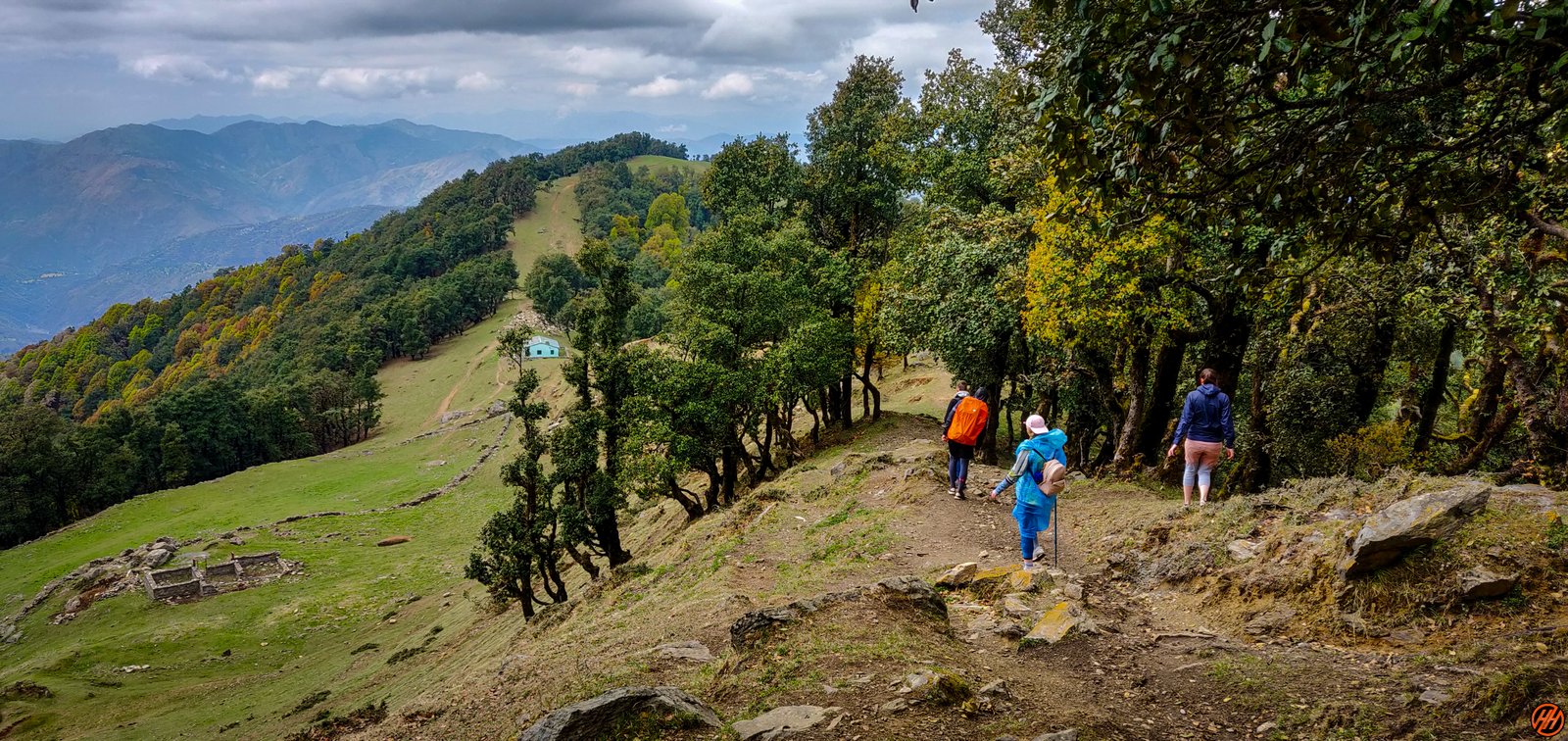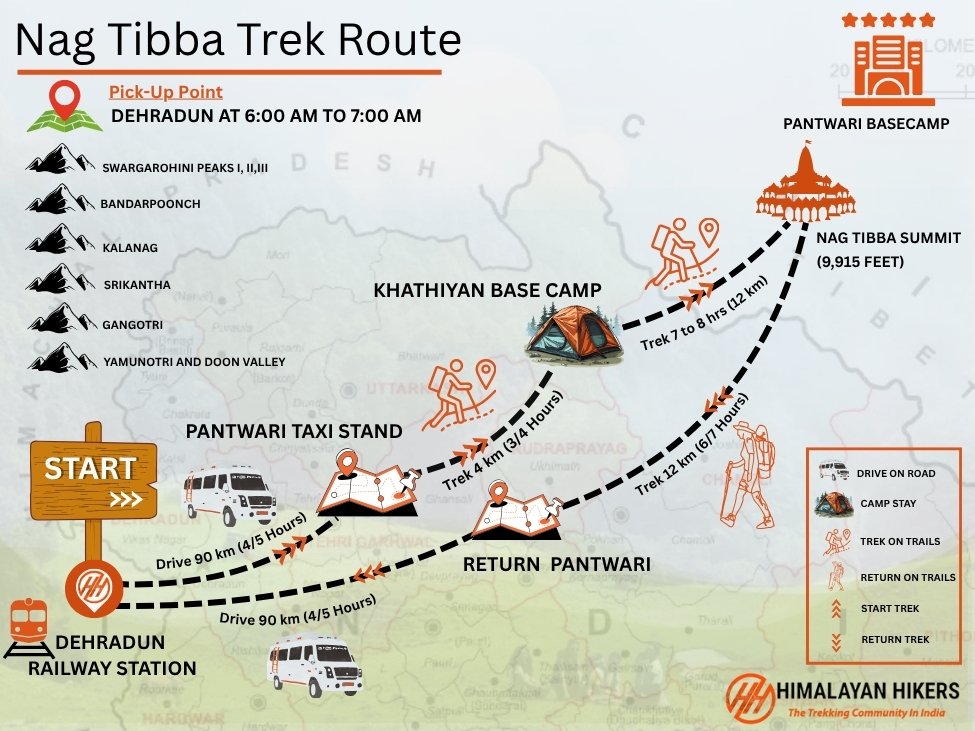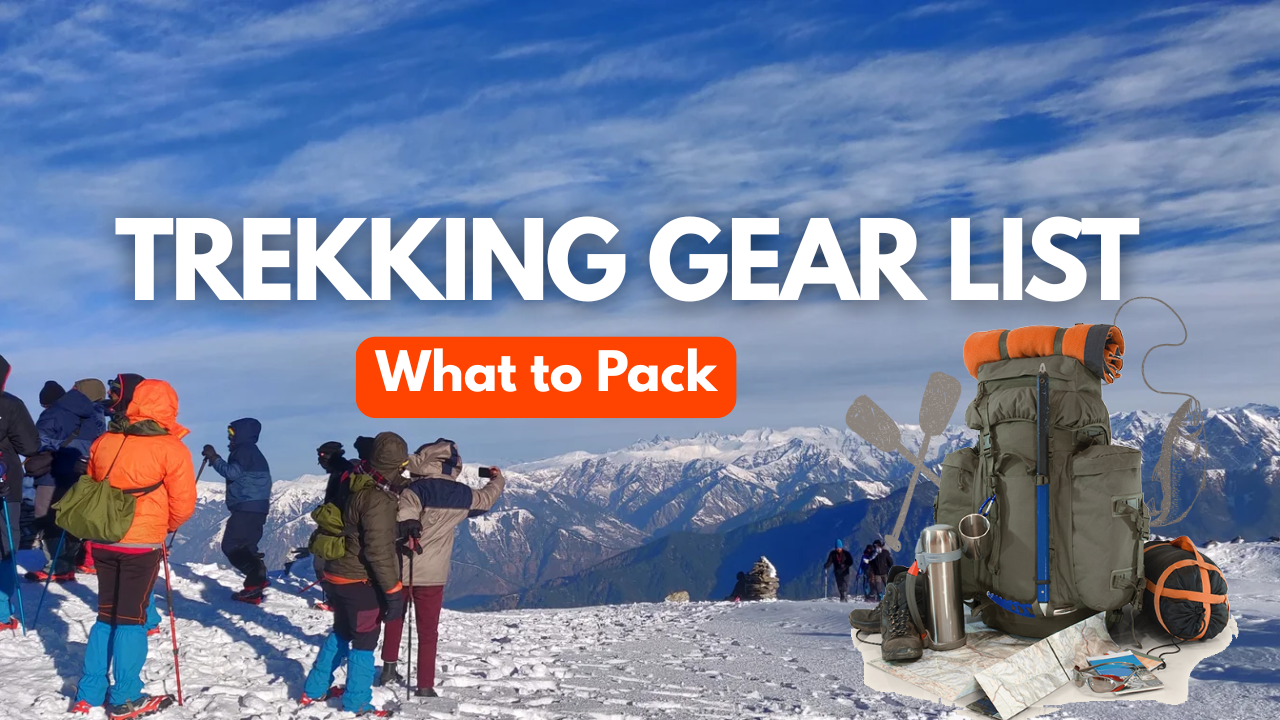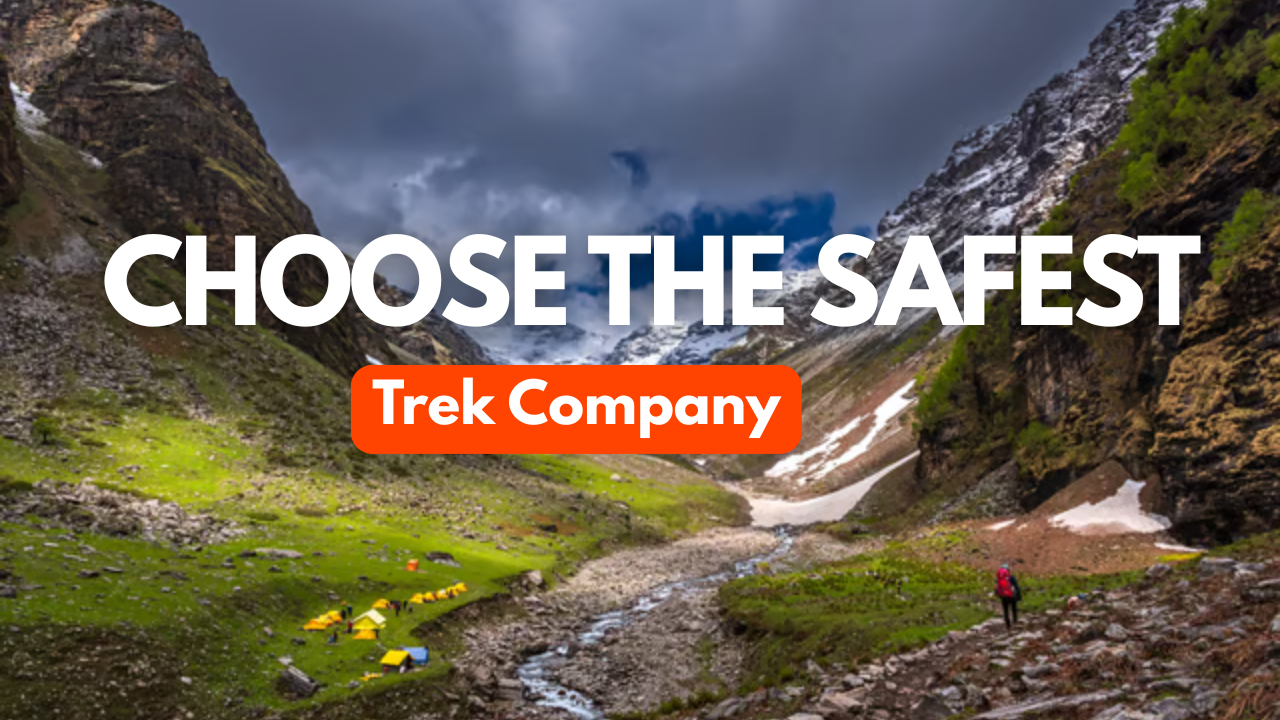The trek is known for its rich biodiversity, and you can expect to see a variety of flora and fauna along the way, including wildflowers, birds, and animals such as barking deer and langurs. So, the picturesque route goes through a beautiful hill station; Mussoorie known as “The Queen of Hills.”
Nag Tibba Trek View Points :-
Stunning views: The trek offers breathtaking views of the surrounding Himalayan ranges, including the Bandarpoonch peak, Kedarnath peak, and Swargarohini peak.
Cultural experience: The trek takes you through several traditional villages where you can experience the local way of life and interact with the friendly villagers.
Flora and fauna: The Nag Tibba trek is known for its rich biodiversity, with a variety of flora and fauna to be found along the way. You can expect to see beautiful wildflowers, oak and deodar forests, and a variety of bird species.
Summit View: The summit of Nag Tibba offers a panoramic view of the surrounding peaks and valleys, making it a perfect spot for photography and relaxation.
Adventure: The trek is a moderate level trek, making it perfect for adventure enthusiasts and beginners alike. It offers a thrilling experience with a mix of steep climbs, rocky trails, and breathtaking views.
Nag Tibba trek can be done from two places, 1. Pantwari Village 2. Dev Thach, there is a lot of pleasure in doing the Nag Tibba trek from both places. These are found in forest forests and beautiful trees like rhododendrons and oaks, pine trees, and some other trees. When we do this trek with Dev Thach, the dense forest and accompanying river drain and the sound of birds along with me make this trek even more exciting.
History of Nag Tibba Trek or Nag Devta Temple:
The history of the Nag Tibba trek is deeply intertwined with the rich cultural and historical heritage of the Uttarakhand region in India. While precise historical records specific to the trek are scarce, the area holds significance due to its association with local legends, religious beliefs, and traditional practices. It is believed by me and all the people who come to do this trek that when you climb this trek from Pantwari to Nag Tibba Base Camp, then you will get some more view of this trek and when you complete this trek, then back down If you get down, you will be able to see this beautiful valley with 150 degrees. You will know when you come to do this trek.
Name and Mythology: The name “Nag Tibba” translates to “Serpent’s Peak” in Hindi. According to local folklore, the peak derives its name from the belief that it is the abode of Nag Devta, the Serpent God, who is revered by the local communities. Nag Devta holds a prominent place in Hindu mythology and is considered a guardian deity.
Religious Significance: The region surrounding Nag Tibba holds religious importance for the local Garhwali people. It is believed that the area is blessed by the Nag Devta and is associated with the worship of snakes. Devotees often visit the Nag Tibba temple, located at the base of the trek, to offer prayers and seek blessings.
Traditional Practices: The local communities have traditionally depended on the forests and mountains for their livelihood. The Nag Tibba trek route was frequently used by shepherds and villagers to move their livestock to higher pastures during the summer months. This seasonal migration, known as transhumance, is an age-old practice in the region.
Historical Connections: While there is no recorded historical evidence specific to the Nag Tibba trek, the region has witnessed various historical events and influences over the centuries. Uttarakhand, once a part of the Kumaon and Garhwal kingdoms, has a history dating back to ancient times. The region has seen the rule of various dynasties, including the Katyuri and the Gorkha rulers, and has also been associated with the influence of the British Raj.
Mesmerizing views During the Trek
This trek takes you through the dense forest which is rich in flora and fauna, and the route further will surprise you because of its beautiful clearings.
Consequently, get amazed by the views of Bandarpunch Peak, Kedarkantha Peak towards the north Kala Nag, Srikanta, Gangotri group of mountains Doon Valley and snow peaks of Changabang are visible from the summit of Nag Tibba Peak .
Indeed, this short trek has a variety of landscapes which makes this trek an interesting one.
But, here are some more easy-level treks for beginners – Phulara Ridge, Deoriatal Chandrashila trek and Dayara bugyal Trek, Brahmatal Trek, Kedarkantha Trek
Nag Tibba Trek Guide
Day 1 : Pickup to you from Dehradun Railway Station Morning 6:30 am to Pantwari by taxi , 90 km (4/5 Hours) same day trek to Khathiyan Base Camp (4 km) (3/4 Hours)
- Pickup Time: 7:00 AM from Dehradun
- Distance: Approx. 90 km
- Total Travel Time: 4/5 hours
- Altitude: Pantwari village: 1,450 m- 4,700 ft.-
- Altitude Khatiyan Camp 01: Camp 1: 2,300 m/ 7,700 ft.
- Accommodation: Overnight stay at Camp
Route- Overview: 7:00 AM: Pick-up from Dehradun Railway Station
Drive to Pantwari on the way View: The journey will be about 90 km, which will take around 4 to 5 hours. The route will pass through Mussoorie, offering scenic views, and a stop at Kampti Fall could be a nice spot to stretch your legs and take in the beauty.
Tip: If you can, try to carry light energy bars, or fruits. During the trek Time
Day 2: Trek from Khathiyan Base Camp to Nag Tibba Summit (9,915 feet) via Nag Tibba Temple and return to Pantwari (12 km) (6/7 Hours) Same day drive to Dehradun (4/5 Hours)
- Start Time:
- Early in the morning, around 6:00 AM or as soon as it’s light enough to safely begin the trek.
- Trek Overview:
- Distance to Summit: Approximately 8-10 km (round trip) from Khatiyan to the summit and back to the base camp.
- Duration: The total trek will take 6-7 hours depending on your pace, including breaks.
- Difficulty Level : Moderate due to altitude and ascent.
- Elevation Gain: From about 2,200 meters (Khatiyan) to 3,032 meters (Nag Tibba Summit), which is a significant elevation gain
- After Lunch Descend Back to Pantwari - Drive Back to Dehradun:
- The drive from Pantwari back to Dehradun will take about 4-5 hours, depending on road conditions and traffic.
- You'll reach Dehradun by 7:00 PM - 8:00 PM
Tip: If you can, try to carry light energy bars, or fruits. During the trek or Travel Time
Day 1 : Pickup to you from Dehradun Railway Station Morning 6:30 am to Pantwari by taxi , 90 km (4/5 Hours) same day trek to Khathiyan Base Camp (4 km) (3/4 Hours)
Total distance – 94 km – 4/5 Hours journey
Mode of journey – By taxi -90 km – On foot – 4 km
Altitude – Khathiyan Base camp – 2325 Meter
Night stay – Our
Campsite – on a twin share basis
The vehicles are arranged from Dehradun Railway Station 6:30 am and the journey starts from there.Cover 90 kms by going through some fable tourist attractions like Mussoorie and Kempty Fall following the route through Nain bagh towards Nag Tibba road. Three routes lead to Nag Tibba but the route via Pantwari village is the shortest one.Reach mini-market, enter the welcome gate and start trekking on the cemented trail. A little ahead is a small temple of Nag Devta.
Now, after 5 minutes of the hike, the trail changes to a rocky one full of loose rocks. As you go higher the Pantwari village and the farmlands are visible below. The connecting Nag Tibba ridge lies in front. Climb the hill and reach a water point, the water here is safe to drink. Continue trekking and great views which the trail offers are a feast for the eyes.
Now, enter the “Pravesh Dwar”; “Welcome Gate” of Nag Tibba and start ascending through the forest section. Rhododendrons (Burans) are found in abundance here and its squash is very famous because it is very helpful in treating blood pressure. The zig-zag trail is steep with many loose rocks.
There are many other short cuts that look alike and lead to the same place but do not go for these shortcuts and leave the group because there is a chance to get lost in the woods.
After 15 minutes, the hike reaches a small clearing and from here you can spot your campsite. Reach there, have sumptuous food and retire for the night. Overnight stay at Camp
Day 2: Trek from Khathiyan Base Camp to Nag Tibba Summit (9,915 feet) via Nag Tibba Temple and return to Pantwari (12 km) (6/7 Hours) Same day drive to Dehradun (4/5 Hours)
Mode of journey – By Taxi -90 km – On foot – 12 km
Altitude Nag Tibba summit – 3022 Meter-(9,915 feet)
Today wake up early because the distance is long, have light breakfast and get ready for the adventure. Go through the densely forested area, in winter trekking here gets tough because the heavy snow makes the trail hard to identify. Between your gradual walk cross some steep ascents and in 1 hour you can reach the Nag Tibba Temple .
It is a wide clearing and a temple is located there dedicated to Serpent God “Nag Devta”. It is worshipped by the local villagers for protection of their cattle and a “Bhagwat” is held here in which “Chief Minister is invited and almost 10,000 people attend it every year. Now, the climb to Nag Tibba top is 1.5 km from Base Camp which is very steep through the thick forest cover.
The snow makes the climb challenging in winters. The trail is straight and you can reach the summit in 1 or 1 and a half hour depending upon the conditions. The highest point is called Nag Tibba, there is a flag “Jhandi” on the top.
Get tremendous views of high Himalayan ranges i.e. Swargarohini, Bandar pooch, Srikanth, Kala Nag, Gangotri and snow peaks of Changa bang. On the other side of the ridge the route to Devalsari village is also visible. Spend a good time there and start the steep downhill trek by following the same route to reach Pantwari. Then, depart to Dehradun via Kempty fall and Mussoorie.
How Difficult is the Nag Tibba Trek?
The Nag Tibba Trek is considered a Easy -moderate-level trek, suitable for both beginners and experienced trekkers.
Trekking Distance and Duration: The total trekking distance of the Nag Tibba trek is around 16 kilometers, depending on the specific route taken. It is typically completed in 1 nights -2 days, Altitude Gain: The trek starts from Pantwari village, situated at an altitude of approximately 1,350 meters (4,430 feet), and the summit of Nag Tibba reaches an elevation of about 3,020 meters (9,910 feet).
Trail Condition: The trail is well-defined and marked, making navigation relatively easy. However, there are sections that involve uphill climbs, steep ascents, and descents. Trekking poles can be helpful for maintaining balance and reducing strain on the knees during these sections.
Fitness Level: the Nag Tibba trek is considered Easy to moderate, it does require a reasonable level of fitness. Regular exercise and moderate fitness preparation before the trek can greatly enhance your experience. It is recommended to engage in activities like walking, jogging, and hiking to improve stamina and endurance.
Weather Conditions: The weather conditions can influence the difficulty level of the trek. During summer and autumn, the weather is generally favorable with mild temperatures during the day. However, the nights can get cold, especially at higher altitudes. Winter treks may involve snow-covered sections, which can make the trail more challenging and require appropriate gear and precautions.
Accommodation: Accommodation Himalayan Hikers camping sites trekkers should be prepared for simple amenities and limited access to electricity and running water.
Is the Nag Tibba trek safe for me?
Yes, Nag Tibba Trek is a safe trek if you are going with a good trekking team which you must know before booking yourself.
It is important for you to know whether the bow trekking organization with which we are going is right or not, And if possible, trek with the local trekking organization in Uttarakhand, you can do the same help all the time.
Then your trek can be very good and memorable, The minimum age required to trek Nag Tibba trek is 7 years and the maximum is 65 years. The rest depends on your fitness.
What do we do for safety on the Nag Tibba trek?
First of all, the safety of trekkers is much more for us, if you see in the trek, then there are all the risks, which I do not think about.
Himalayan Hikers worry more about you that no one should ever have any problem in the trek.
What should we and you do to keep more safe on the trek?
- Whenever you are going for any trek, it is very important that you go completely fit and ready.
- The trek is not difficult, if you make your feet and your mind calm and strong, you will find the trek very easy.
- While trekking, keep in mind that you are walking on the right route or not always with your guide.
- Most people look somewhere and where they are walking, this can cause twitching in your legs, which can ruin your entire trek.
- It is important to ask your doctor if you have any medical problems.
- I should always keep my medical kit with me, it is very important.
- Himalayan Hikers always keep a medical kit with you, such as oxygen cylinders, and medicine to be given in emergency on the trek If any trekkers have any more problems, then they are brought back to the base camp by laying them in the stretcher.
- Our camp in Nag Tibba trek is around the tree line where you cannot have any problem of oxygen.
- In case of any medical problem, the help of your guide or well-informed trekkers should be taken
- If there are major health problems in Nag Tibba trek, then Nearest Hospital is in Nainbag which is about 27 Kms away from Nag Tibba trek. and Vikasnagar 97 Kms away.
Best Time to Do Nag Tibba Trek?
Nag Tibba Trek is a very beautiful and Easy trek in the Uttarakhand Himalayas near Mussoorie, The Nag Tibba Trek is great for those people who have a great passion for mountaineering and consider it a special purpose in their life. Nag Tibba is such a trek where you get to see more than one Himalayan mountain range. Nag Tibba Trek is very important for those people who have holidays only on weekends.
We are the local people in Uttarakhand who are doing this trek for years, we have every experience related to this trek.
You can do Nag Tibba Trek throughout the year, For those who like summer treks, they can go summer and winter treks are a very good time for those who want to see snow. and live snow fall,
Nag Tibba Trek is also a good trek for Monsoon trek at that time there are flowers and green greenery which makes the trek very memorable.
The Nag tibba trek starts from Pantwari market in Uttarakhand which comes in Jonsar bawar Range
During the day the temperature of Nag tibba trek is around ( 08°C to 20 °C and during the night the temperature comes down to 05 °C to 08 °C which is not bad.
You will never consider yourself boring in Nag tibba Trek, this trek can give you nothing but joy, You will get to see the Jonsari culture in this trek which will always keep you connected towards the mountain. Himalayas
Why choose Nag Tibba Trek?
Before heading towards the itinerary, it is really essential to perceive the reason behind choosing Nag Tibba Trek.
See firstly, the trekking distance is a total of by taxi 180 Km and on foot 16 km which is to be covered in 2 days. Dehradun to via Mussoorie to nainbagh and pantwari village
Nag Tibba trek is a low altitude mountain trek Altitudes is 3022 Meters
The Starting trail is easy as compared to other treks this is an easy trek. So this trek is best for family and beginners, school tour weekend trek
You got to see so many heavenly bodies at one place like the panoramic view of the Himalayan ranges, you can see pine forests, different varieties of flora, and fauna surpassing through bona fide Garhwali culture.
I think Do spare time in Interaction with our local team, and you will get to know about some of the ancient tales of Indian mythology and our local cultures, these is good ideas for trekkers
Beautiful landscapes so carry proper photo gear & Extra battery backup.
The backpack should not exceed 6 kg only.
Weather conditions nag tibia trek?
The weather conditions during the Nag Tibba trek can vary depending on the time of year you plan to undertake the trek. Here’s a general overview of the weather conditions during different seasons:
- Summer (April to June): This is considered the best time to visit Nag Tibba. The weather during these months is generally pleasant with mild temperatures during the daytime, ranging from 15°C to 25°C (59°F to 77°F). However, it can get colder during the evenings and nights, with temperatures dropping to around 5°C to 10°C (41°F to 50°F) or lower, especially at higher altitudes. The days are usually clear, providing excellent visibility for enjoying the panoramic views from the summit.
- Monsoon (July to September): The monsoon season brings moderate to heavy rainfall in the region. Trekking during this time can be challenging as the trails can become slippery and muddy. Moreover, there may be an increased risk of landslides. It’s generally not recommended to undertake the Nag Tibba trek during the monsoon season due to safety concerns and limited visibility due to cloud cover.
- Autumn (October to November): This is another good time to visit Nag Tibba. The weather remains pleasant, with mild temperatures during the day, ranging from 10°C to 20°C (50°F to 68°F). The nights start getting colder, with temperatures dropping to around 0°C to 10°C (32°F to 50°F) or lower, especially at higher altitudes. The skies are usually clear, offering beautiful views of the surrounding peaks and landscapes.
- Winter (December to March): Winter brings cold weather to the Nag Tibba region. The temperatures during the day range from 5°C to 15°C (41°F to 59°F), but they can drop significantly during the nights, often reaching sub-zero temperatures. The higher altitudes may experience snowfall, adding to the scenic beauty but also making the trek more challenging. It’s important to be well-prepared with warm clothing and appropriate gear if you plan to trek during winter.
Your travel plan for the Nag Tibba trek
You can book train, air flight, and bus tickets for your journey only according to the information given by us.
The Nag Tibba trek will be of 01 nights 2 days from Dehradun to Dehradun including travel
How to Reach Dehradun Railway Station
First of all, all the trekkers will have to book their flight and train bus according to our timetable as our pick-up is from 6 am to 7 am, you will have to reach Dehradun in the morning.
Whether you’re coming from Delhi, Mumbai, or another city, here are your options to reach Dehradun:
By Air
- The nearest airport is Jolly Grant Airport, located about 25 km from
- Dehradun city. Regular flights connect it to Delhi, Mumbai, and other major cities.
- You can take a cab or local bus from the airport to the railway station (approx. 45–60 minutes).
By Train
- Dehradun Railway Station is well-connected to Delhi, Haridwar, Lucknow, and other major cities.
- Trains like the Nanda Devi Express and Shatabdi Express are popular choices.
Pro Tip: Buses are also available from cities like Haridwar, Moradabad, Rishikesh, and Chandigarh.
By Road
- You can take overnight buses from Delhi ISBT (Kashmere Gate) to Dehradun.
- Buses range from budget options to luxury Volvo coaches and usually take 6–8 hours.
- You can take a local bus, Vikram, or a private taxi to reach the pickup location from Dehradun ISBT.
- The travel time is around 20-30 minutes, depending on the traffic in the city.
Himalayan Hikers organize transport to Pantwari base camp from Dehradun railway station. Our vehicles leave at 6:00 am to 7:00 am sharp from Dehradun. The taxi costs include your package for a Tempo Traveler.
Sharing In Dehradun railway station you will get our staff that will arrange transport for you. The contacts no Transport coordinator or our office team will be giving you a week ago to your departure
Please, you guys book your transport facility according to your own time table, after Himalayan Hikers take all the responsibility of Dehradun to Dehradun, that you will not face any problem.
How to Reach Pantwari Village for the Nag Tibba Trek?
The Nag Tibba trek is located near the town of Pantwari in the Uttarkashi district of Uttarakhand, India. Here are the different ways to reach the Nag Tibba trek:
By Air: The nearest airport to Nag Tibba is Jolly Grant Airport in Dehradun, which is about 90 km from the starting point of the trek. From there, you can hire a taxi or take a bus to Pantwari.
By Train: The nearest railway station to Nag Tibba is Dehradun railway station, which is about 75 km from Pantwari. From there, you can hire a taxi or take a bus to Pantwari.
By Road: Pantwari is well-connected by road, and you can reach there easily by bus or taxi from Dehradun, Mussoorie, or other nearby towns. It takes around 4-5 hours to reach Pantwari from Dehradun by road.

Mandatory Documents
Original and photocopy of government photo identity card- (Aadhar Card, Driving License, Voters ID, etc,)
Passport and Visa important to foreigners
Medical Certificate (First part should be filled by the Doctor and Second part by the Trekker)
Declaration Certificates
Note: – Many trekkers commit the same mistake of carrying unnecessary items on a trek which only makes the backpack heavy. It is important to know the right items to carry. It differs from season to season if you are trekking in summers then carry less layers of warm clothing and if you are trekking in winters carry enough layers to protect yourself against chilly cold.
Necessary Items for trekkers
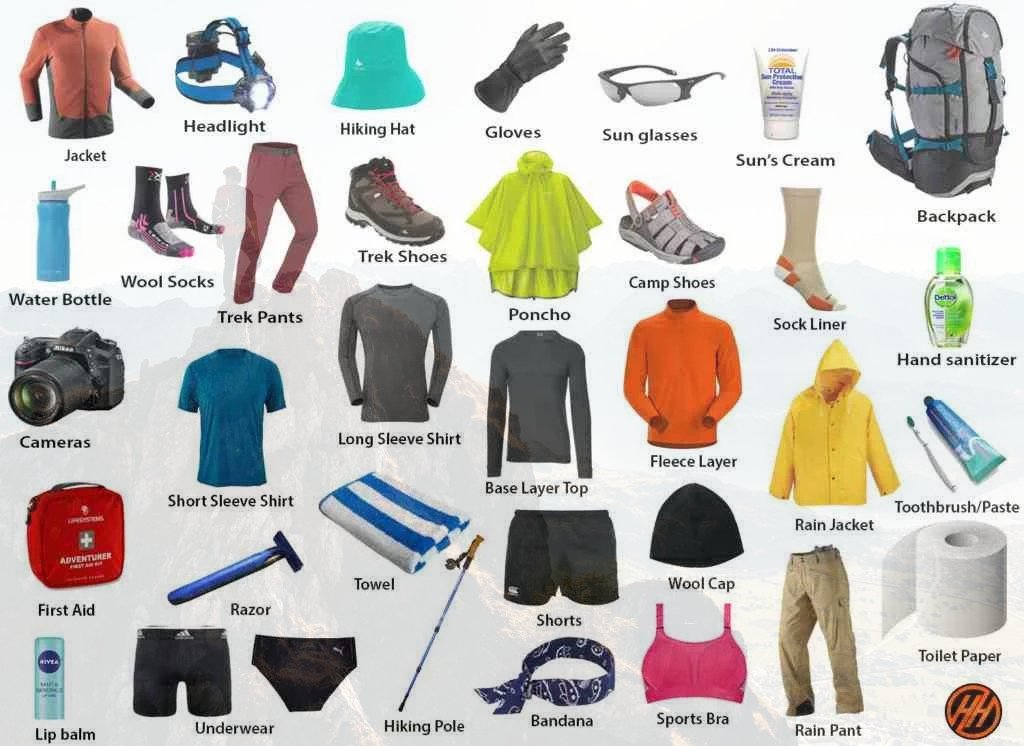
Basic Trekking Gears

The Clothes You Should Bring On Satopanth Expedition

Head Gears

Foot Gears

Personal Care Essentials

Carry a Personal Medical Kit
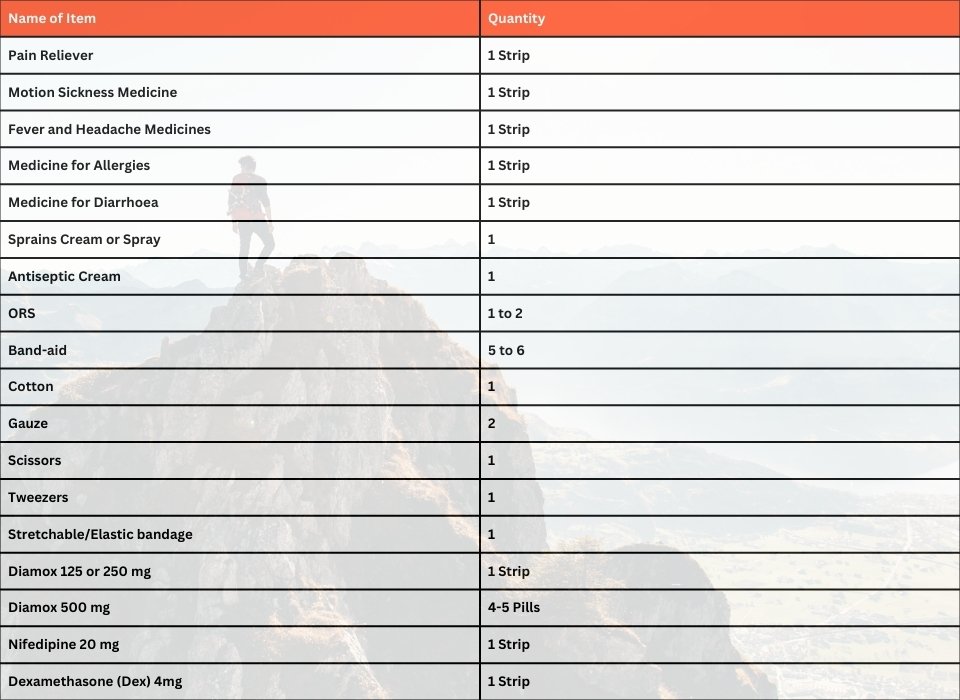
Are you Looking for Trekking Equipment on Rent?
If any trekker requires trekking equipment on rent, Himalayan Hikers offers the best-quality gear available for rental. Many individuals are in need of such equipment, and renting provides a cost-effective solution, allowing them to access high-quality gear at an affordable price without the need for a significant investment for short-term use.

Trek Equipment You can book directly on first day at the Base Camp.
Note:-
Please take all medicines only when prescribed by the doctor. In case you face any problem during your trek,
discuss and take advice from the Professional guide.
The Trek is one of the most popular treks in Uttarakhand, Himachal,Kashmir,Laddakh,Sikkim,Nepal, requiring both physical preparation and mental readiness. Although it is categorized as a moderate trek, reaches an elevation of over 12,720 feet and traverses remote Himalayan terrain, which can be physically and mentally challenging. Here's how you can prepare yourself for a safe and successful accomplishment of the Trek:
Physical Fitness
Building a good fitness base is essential for every trekker. The Trek itinerary involves 5 to 6 hours of walking every day. Though the trails are well-marked, they are often bumpy and include steep uphill sections, which may affect your stamina. You can overcome your physical limitation with a 6-week training program that you can begin about 2 months before your Trek. Your 6-week fitness routine should include

Pro Tip: If you have time, you can skip the Sunday training and go for a long-distance walk or mini day-hike (7–10 km) with a loaded backpack to simulate real trekking conditions. A short 1-day hike around your city/town can help a lot.
Mental Preparation
Physical strength is only half the journey, the other half is mental resilience. The trail takes you through remote clearings, steep climbs, cold starry nights, and no mobile connectivity. Be prepared to:
(I) -
Detach from the digital world.
(II) -
Embrace basic mountain living (camping, toilet tents, limited electricity).
(III) -
Push through moments of fatigue, weather discomfort, or altitude effects.
Himalayan Hikers is a reputable trekking company that places a high priority on safety. Here are some of the safety measures they take to ensure the safety of their clients during the Trek:
Experienced Guides: Himalayan Hikers hires experienced and certified guides who are well-versed in the terrain, weather conditions, and local culture. These guides have first-hand knowledge of the routes and are equipped to handle any emergency situations that may arise.
Proper Gear: The company provides all the necessary gear and equipment to their clients to ensure comfort and safety during the trek.
Hygiene and Sanitation: Himalayan Hikers places great emphasis on hygiene and sanitation during the Trek. They provide clean drinking water, hand sanitizers, and toilet tents to ensure that their clients are healthy and comfortable.
Emergency Services: The company has a well-defined protocol for handling emergency situations. They have a team of trained medical professionals who are available 24/7 and can be quickly mobilized in case of an emergency.
Acclimatization: Himalayan Hikers follows a gradual acclimatization process during treks to ensure that their clients adjust to the high altitude gradually. They also monitor the health of their clients regularly and provide necessary medical attention if required.
Overall, Himalayan Hikers places a great emphasis on safety and takes all necessary measures to ensure the safety and well-being of their clients during treks.
Trek Inclusions
| Transport | Dehradun to Dehradun round-trip via Tempo Traveller (Pickup & Drop) |
| Permits & Entry | Forest Permit and Entrance Fees |
| Accommodation | Camp Accommodation on Twin/Triple Sharing |
| Meals | Breakfast, Lunch, Tea, Coffee, Snacks, Soup, Dinner (All meals included) |
| Trek Guides | Experienced Trek Leader & Technical Guide |
| Safety Equipment | Medical Kit, Oxygen Cylinders, Pulse Oximeter (Pulse Ox) |
| Trekking Equipment | Crampons, Gaiters |
Trek Exclusions
| Category | Details |
|---|---|
| Meals (Not Included) | – Day 1: En route Breakfast (not included) to base camp– Day 2: En route snack & Dinner (not included) |
| Insurance & Documents | – Personal Insurance– Medical Certificate (Mandatory for age 50 and above) |
| Personal Essentials | – Personal Toiletry Items– Personal Medical Kit |
| Porter Service | – Porter fee: ₹400 per day (to be paid directly at Sankri base camp)– Minimum bag weight for porter: 8 kg |
| Foreign Nationals | – ₹800 extra for trekking permit– Passport and valid Visa required |
Important Note
Himalayan Hikers offers both online and offline booking options for their treks. Here’s a breakdown of both options:
1. Online Booking:
- Website: Himalayan Hikers has an official website where trekkers can browse through different treks, check details (itineraries, costs, difficulty level, etc.), and make bookings. Payment gateways are integrated for secure online transactions.
- Third-Party Platforms: They might also be listed on various trekking or adventure booking platforms, where you can compare prices, read reviews, and make bookings.
- Email Communication: Trekkers can inquire about treks via email and complete the booking process online, following email communication and payment.
2. Offline Booking:
- Direct Office Visit: Himalayan Hikers has physical offices (especially in Uttarakhand), where trekkers can visit in person, discuss treks, and complete bookings directly.
- Phone Booking: You can also call their office to make a booking. Details about payment methods, trek dates, and other logistics can be confirmed over the phone.
Yes, Himalayan Hikers requires a 25% advance payment for booking treks, Via- Google pay or UPI, Directly Himalayan Hikers Account with the remaining amount to be paid in cash at their branch office in Sankri before the trek starts. This payment structure is typical for ensuring that bookings are confirmed while allowing trekkers flexibility in completing the payment when they arrive.
Nag Tibba, also known as the “Serpent’s Peak,” is situated in the Tehri Garhwal district of Uttarakhand, India. It lies close to Mussoorie and is part of the lower Himalayan ranges.
Perfect for first-time trekkers, families, school groups, and weekend adventurers.
The trail passes through villages, dense forests, meadows, and rocky sections, with some gradual climbs.
Winter (Nov–Mar) for snow; Summer (Apr–Jun) for clear weather. Avoid monsoon (Jul–Sep).
Yes, heavy snow can be seen between December and March.
Temperatures can drop to -5°C at night during peak winter.
Daytime 15–25°C, nights 5–10°C.
Not advisable — the trail becomes slippery and prone to leeches.
Yes, there are designated campsites near Nag Tibba Base and Kathian. Many trekking companies provide tents, sleeping bags, and meals.
If you’re trekking independently, yes. If booked through an agency, they usually provide all necessary equipment.
Yes, Pantwari Village has several homestays and budget lodges.
There are a few natural water streams, but carrying bottled or filtered water is recommended.
Network is available until Pantwari; beyond that, signal is weak or non-existent.
You can view stunning peaks such as Bandarpoonch, Swargarohini, Kedarnath, Gangotri, and Doon Valley.
The sunrise and sunset from Nag Tibba summit are breathtaking — among the best in Uttarakhand.
Yes, the Nag Devta Temple, dedicated to the Serpent God, is located near the base camp.
You’ll pass through oak, deodar (cedar), and rhododendron forests rich in flora and fauna.
Occasionally, trekkers spot mountain foxes, langurs, and various bird species.
You don’t need to be an athlete — basic fitness (daily walking or light jogging) is sufficient.
Trekking shoes, warm clothes, torch, raincoat, personal medicines, snacks, water bottle, power bank, and a first-aid kit.
Yes, children above 7 years and healthy adults up to 60+ can do it safely.
No government permit is required for the Nag Tibba trek as of now.
The trail is safe, but one should be cautious of slippery paths during snow or rain.
Yes, Nag Tibba is one of the safest solo treks in India — just ensure you have offline maps and inform someone about your plan.
Depending on the package and season, the cost ranges between ₹1,500 – ₹4,000 per person, including food, guide, and camping.
Small bonfires are allowed at designated campsites, subject to forest department rules.
No. Once you leave Pantwari, you’ll likely be offline, which adds to the serene and disconnected experience.

